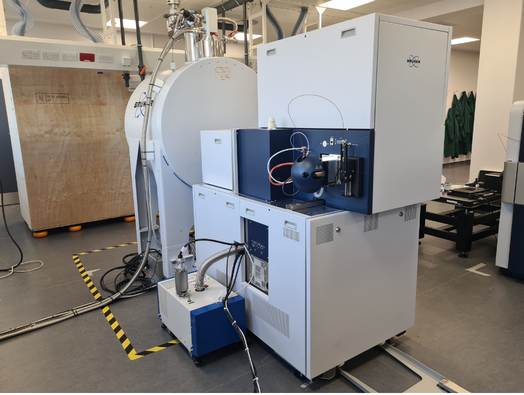A new and unique mass spectrometry instrument has arrived at the Rosalind Franklin Institute
A new and unique mass spectrometry instrument has arrived at the Rosalind Franklin Institute as a part of our collaboration with the instrument manufacturer, Bruker.
The instrument is designed to be a precision tool for the structural study of biomolecules. In biology, shape and function are closely linked, so studying the shape of biomolecules tells us how they might work, and how we can bind drugs to them if they’re linked to a disease.

This new TIMS MRMS instrument combines trapped ion mobility spectrometry (TIMS) with the magnetic resonance mass spectrometry (MRMS) technique. The TIMS cell probes the shape of biomolecules, while the MRMS lets us fragment biomolecules in many different ways to study and elucidate aspects of their internal structure. The MRMS detector based on Fourier transform-ion cyclotron resonance (FT-ICR) technology has unparalleled mass resolution and accuracy, so we can differentiate between very similar mass biomolecules that other instruments wouldn’t be able to resolve.
The design of the TIMS-MRMS instrument integrates TIMS and FT-ICR technology. The front end of the instrument contains the TIMS cell and is tuned to reduce the energy of biomolecules flying through the instrument before they reach the FT-ICR detector at the back end. Proper control of the energy of biomolecules within the instrument ensures fidelity of the measurement and avoids changing the key biomolecular structure from its original state, a requirement not well produced in other instruments.
Due to a unique source design with dual electrospray ionisation (ESI) and matrix-assisted laser desorption/ionisation (MALDI) sources, the instrument can also be operated in a MALDI imaging mode, where we liberate biomolecules from a flat biological sample (usually a tissue section or cell culture dish) in a spatially resolved way. We then reconstruct an image of the sample based on where we detected which biomolecules.
Our goal is to harness the structural capabilities of the instrument to probe and track structural changes of specific biomolecules across the biological sample. These abilities are especially important for disease samples where we aim to correlate differences in folding states for biomolecules of disease vs. healthy samples to gain insight in disease mechanisms.
